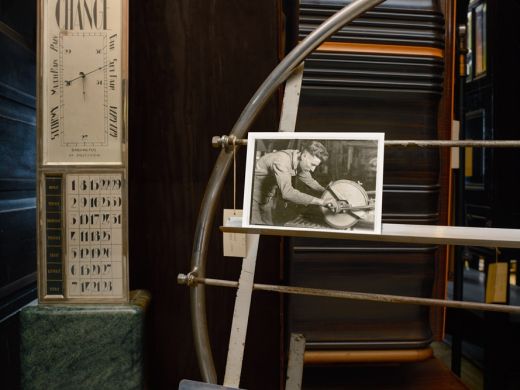Esther Shalev-Gerz: Describing Labor
Gean Moreno

Esther Shalev-Gerz, Describing Labor – Grinding Metal Castings, 2012 , Color photograph, 39 3/8 x 51 1/8 inches. Commissioned by The Wolfsonian–Florida International University, Miami Beach, Florida, 2012.
Wolfsonian-FIU
November 29, 2012-April 7, 2013
Here’s how things went: Shalev-Gerz selected forty-one items, mostly from the Wolfsonian’s holdings, depicting laborers. She then invited 24 individuals to select one and describe their reason for the choice as she recorded them. These individuals placed their selected objects on the racks of the institution’s storage facility and, as the press release explains “[Shalev-Gerz] photographed its representation of labor in situ with other products of labor.” The result is a well-distributed installation of Shalev-Gerz’s images, glass hammers and gloves, a pair of sound pieces, and a two-channel video of the participant interviews. Their explanations are accompanied by panning close-ups of the works.
The first thing one has to ask is whether personal selection isn’t the most reactionary form of engagement with the concept of labor and the complexity of its descriptions. In the video, the invited parties justify their choices by alluding to family history, by comparing railway workers to 9/11 first responders, by reading religious and mythological references in the poses of the laborers depicted, by relating stories of provenance, and by drawing art historical correspondences. It’s commentary on the objects themselves. Labor and its objective conditions are exiled from the picture. Aside from serving as theme, labor is hardly engaged. And its description, perennially contested space, is treated as if things were settled. Labor’s revenge, however, is that it becomes a haunting figure at the center of the show, the gap around which it revolves but never touches. The show is, on the surface, about description, and its engine is the unshakeable de-historicizing impulse embedded in personal testimony. But its rogue subterranean dynamic, animated by unintended consequences, involves something else altogether.
First unintended consequence: the exhibition points back to, without ever engaging, what was really at stake in the depiction of labor at the beginning of the 20th century. It reminds us that labor produced a dangerous political Subject and that the site of labor—the factory, but also the mine and the foundry and the workshop—became the point of emergence for a call to universal equality. Discussing the photograph he selected, one of the commentators in the video describes the way in which purpose is inscribed in the bodies of steel workers on a skyscraper skeleton and of the way in which this sense of purpose was so powerful that it trumped personal safety. The question is: What is their purpose exactly? The answer is colored by the angle from which one approaches the image. From one side, their purpose is to finish their task, to heroically usher in modernity, to birth New York and the modern metropolis. From another side, their purpose, as part of a class formation, is to abolish altogether the kind of (wage) work they are engaged in. A positivist reading sees dignity in the body of the worker, in the labor power he stores and can unleash to produce modern marvels. Another reading sees the dignity registered on that body as bound to the struggle for a world of more egalitarian and dignified social relations. There is a construction of the worker that favors the dominant ideology and there is the self-presentation of the worker as a political Subject. The impossible neutral point between these two descriptions could have been the vital core of Shalev-Gerz’s project. As it turns out, it is the exhibition’s disavowed truth. It’s the agitated gap that, while never engaged, invites a politically- and historically-informed reading of the exhibition that overrides any personalized takes on individual objects depicting laboring bodies.
Second unintended consequence: the exhibition itself highlights the conditions of contemporary labor absent from the old objects selected. We see the movement from traditional depictions of workers to the immaterial, semiotic production of the artist’s visual production and exhibition composition. Furthermore, we see how this movement happens through the conservative “translating machine” of personal reaction and selection—that of other “immaterial” workers: artists, poets, curators, collectors, etc.
Missing in the exhibition is a bit of accounting for what is happening when these images are put back into circulation in the particular way in which it is done here. Missing, also, is an understanding that there is no neutral ground from which to describe labor. To stand on “neutral” ground is to have already picked a side.










